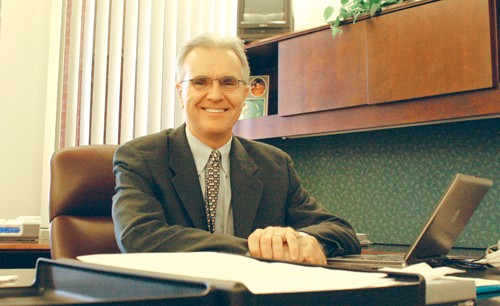University Medical Center is facing tough economic challenges, but the new CEO, Kevin Burns, said layoffs are not an option.
“”You don’t do this without good people, we have to support our staff,”” Burns said. “”To me, layoffs are not an option, we have to invest our way though this difficult economic climate.””
Burns took over for former UMC CEO Greg Pivirotto on Feb. 1, after Pivirotto retired.
“”Greg was well-loved by all the staff. One of the things that I’m going to continue that Greg (Pivirotto)started is that he made rounds on the units several days a week, besides just walking around saying, ‘Hi, how are you doing?'”” Burns said. “”It’s a formalized process started many years ago, and I think that’s one reason why the staff respected him is because he took a direct interest in what they do.””
Prior to becoming CEO, Burns spent the last eight years as UMC’s chief financial officer. Before that, he spent 17 years with the accounting firm Arthur Andersen, which specializes in health care.
“”One reason why I came here was my respect for (Pivirotto), I know he runs an organization that is culture driven and quality driven,”” said Burns, who earned an accounting degree from Arizona State University in 1981. “”I would hold our culture up to anyone.””
In the last 10 years, UMC has become the only Level-I Trauma center for southern Arizona. UMC has also added the Diamond Children’s Medical Center and the Arizona Cancer Center.
The hospital has consistently been ranked as one of the best in the country, and in January, it was ranked in the top 10 best hospitals by Becker Hospital Review magazine.
Despite the recognition, Burns will be facing some major challenges thanks to an executive order issued by Gov. Jan Brewer that cuts funding to graduate medical education for 2010.
The UMC will lose $8 to $9 million, according to Burns.
“”Clearly the budget problems of the state of Arizona are an area of concern,”” Burns said. “”Not just what it does to UMC, but what it does to our colleges in academia at the UA. There are two large areas of infrastructure that the state must support, (one) is education and the other is heath care. We must have a good infrastructure if we want to train the next generation of doctors, nurses, engineers and mathematicians.””
Burns added that with a solid infrastructure of education and health care, more businesses would be attracted to the state.
“”When organizations are looking to move to another state, they look to see if (the state) has a vibrant economy here, but they also look to see if they have a good education system here, do they have a strong infrastructure for health care,”” Burns said.
While the state budget is a concern, the main worry Burns has is how to provide adequate health care for the growing population.
“”We’ve actually talked about it in our strategic planning, that someday there will have to be another facility for patient care,”” Burns said. “”Will there be a new state-of-the-art UMC facility that either replaces this one or complements this facility? That is something that we’ve already started thinking about roughly, but will become a reality as the state continues to grow.””
Like his predecessor, Burns also has high hopes for the Arizona Cancer Center.
“”That gives us enough area to have a very strong clinical campus that focuses on cancer care,”” he said. “”We will certainly build that out. It’s possible in 10 to 20 years from now that you could have an even more expanded (facility).””
While the job of managing a major hospital in a growing metropolitan area can be a daunting challenge, it is one that Burns is ready to tackle.
“”There are plenty of challenges, and I’m appreciative of my predecessor Greg (Pivirotto) asking me to accept this position, and I look forward to working with everyone here at UMC.””









